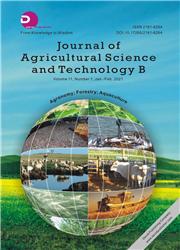Determination of Leafy Vegetables Need in Water and Nitrogen Use Efficiency by Using the Diviner 2000 and the Isotopes Techniques: Case of Amaranth (Amaranthus cruentus)
引用次数: 0
Abstract
A study was conducted to determine how the nitrogen (N) in the fertilisers can be quantified and what amounts of fertilizers should be given to leafy vegetables to achieve their requirements. This study also aimed to determine the efficient use of water by the plant. The experiment was laid out in a randomized complete block with three replicates and three levels of urea (T0 = 0 kg/ha, T1 = 43.5 kg/ha, T2 = 65 kg/ha). Estimation of growth parameters and biomass yield revealed that the treatments produced statistically identical values. But numerically, T1 (43.5 kg of urea/ha) gave the highest yields and T2 (65 kg of urea/ha) produced the lowest. It was the same for the determination of the water use efficiency (WUE) by the plant where T1 produced the highest values compared to T2. The yield curve as a function of the applied urea dose allowed the identification of the urea dose that corresponds to optimal yield in amaranth. From the dose of 65 kg of urea/ha, any increase becomes harmful to the plant. This results in a decrease in yield in the amaranth plant.利用Diviner 2000和同位素技术测定叶类蔬菜的水分和氮利用效率——以苋(Amaranthucruentus)为例
进行了一项研究,以确定如何量化肥料中的氮,以及应向叶菜提供多少肥料才能达到其要求。这项研究还旨在确定植物对水的有效利用。实验在一个随机的完整区块中进行,有三个重复和三个水平的尿素(T0=0 kg/ha,T1=43.5 kg/ha,T2=65 kg/ha)。对生长参数和生物量产量的估计表明,处理产生了统计上相同的值。但从数量上看,T1(43.5公斤尿素/公顷)产量最高,T2(65公斤尿素/ha)产量最低。与T2相比,T1产生最高值的工厂的水利用效率(WUE)的测定是相同的。作为所施加的尿素剂量的函数的产量曲线允许识别与苋的最佳产量相对应的尿素剂量。从每公顷65公斤尿素的剂量开始,任何增加都会对植物有害。这导致了苋属植物的产量下降。
本文章由计算机程序翻译,如有差异,请以英文原文为准。
求助全文
约1分钟内获得全文
求助全文

 求助内容:
求助内容: 应助结果提醒方式:
应助结果提醒方式:


